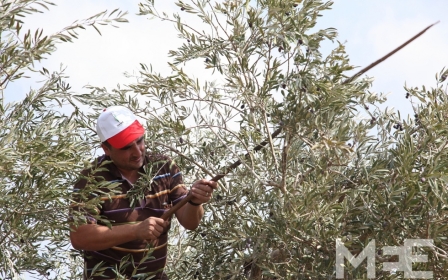Visualising 'E1'
The view from Nakhayleh
The 360 degree vista from atop a dry and dusty hill overlooking the Palestinian Bedouin village of Nakhayleh in the central West Bank holds huge political significance to the possibility of a Palestinian state ever being established on the 1967 borders. It is from that vantage point that a clear understanding of the proposed Israeli “E1 plan” can be visualised.
In a September press release, UNRWA Commissioner General, Pierre Krahenbuhl stated, "If such a plan were implemented, this would not only give rise to concerns that it amounts to a ‘forcible transfer’... it might also make way for further Israeli illegal settlement expansion, further compromising the viability of the two state solution."
Looking north of Nakhayleh, across barren land that Israel declared the 'Wadi Kelt Nature Reserve,' the white houses and red roofs of Almon settlement are visible. Almon was established in 1982 on top of the Wadi Kelt river, the largest natural water resource in the West Bank.
It was the close proximity to Wadi Kelt that brought the Bedouin of Nakhayleh to the area, following their forced displacement from the Naqab during the Nakba. However, since the establishment of the settlement and nature reserve, they have been denied access to any natural water resources. They are also denied access to mainline infrastructure, including water and electricity by Israel - which is in full civil and military control of the area as it falls within 'Area C' of the Oslo Accords.
Neighbouring Almon, is the settlement of Kfar Adumim which is home to Uri Ariel, the Israeli Minister of Housing and Construction, who in April 2013 was quoted as having called the proposed construction in E1 “our right and our obligation.” Demolition orders placed on Palestinian houses are issued by Ariel's Ministry of Housing and Construction. Every standing structure in Nakhayleh has a current demolition order.
Nakhayleh is bordered to the west by the main road that links the southern and central West Bank and, to the east, by a dirt track that marks the border of the Israeli nature reserve. Villagers are denied grazing access to lands beyond both roads. They are, therefore, left with a tiny patch of barren land, measuring maybe 500 square metres, with no grazing opportunities and no basic infrastructure.
South of the village lies the major settlement industrial zone of Mishor Adumim, alongside which is Ma'ale Adumim - home to 43,000 settlers. Continuing in a clockwise direction, the eye next meets the E1 Israeli police station, the only Israeli building constructed as part of the E1 plan to date. Buildings on the Mount of Olives can also be seen in the distance.
The E1 plan was initially devised by former Israeli prime minister, Yitzhak Rabin in 1995, and is designed to create Israeli territorial contiguity between Jerusalem and the West Bank’s third largest settlement, Ma'ale Adumim. Its designs include the construction of thousands of settlement housing units inside the West Bank and the mass forced transfer of Palestinians currently living in that area.
It will also have a devastating impact on neighbouring Palestinian communities, as Israeli human rights association B'Tselem documented in a 2013 report:
"The implementation of construction plans in E1 will... exacerbate the isolation of East Jerusalem from the rest of the West Bank and disrupt the territorial contiguity between the northern and southern parts of the West Bank.”
The case of Khan al-Ahmar
A kilometre or two from Nakhayleh lies another of the communities slated for forcible transfer. Khan al-Ahmar is divided into five separate and individually named clusters of ramshackle huts and tents. In common with other Palestinian communities in the area, Israel refuses to grant building permits in Khan al-Ahmar.
Abu Ra'id is the muhktar (community leader) of Khan al-Ahmar 'Mihtawish', he rejects the E1 project entirely and will discuss only two plans:
"Our first demand is that we return to our homes in the Naqab from which we were displaced in 1948. Our second demand, is that until that happens we will discuss plans for developing Khan al-Ahmar."
Before news of the E1 plan went public, the villagers of Khan al-Ahmar had already been working on plans of their own according to President of the Jerusalem Bedouin Committee, Abu Suleiman:
"We created plans to improve our lives here until we go home which include construction of mosques, schools and connection to infrastructure. These plans have not yet been submitted to the Israeli courts, although we submitted them to the Israeli planning committee who rejected them."
The land on which the residents of Khan al-Ahmar re-established their community-in-exile is owned by the Palestinian towns of Assariyya and Anata. Bedouin community leaders have therefore discussed their development plans with both town councils and received their full backing.
Israel's E1 plan calls for the “relocation” of thousands of Bedouin to facilitate settlement development in the area. These “relocation” plans have been labelled "individual and mass forcible transfers and forced evictions" in United Nations' reports, which are "contrary to Israel's obligations under international humanitarian and human rights laws." Settlement construction on occupied land is also in breach of international law.
The planned Nuweima “township”
Members of the Rashaida Bedouin tribe have been living in Nuweima - the site of the planned township - since their displacement from Ein Gedi during the Nakba. Nuweima straddles Areas “A” and “C,” and for many years has suffered regular house demolitions. According to village muhktar, Abu Faisal, Israel has issued more than 1000 demolition orders in Nuweima since 1967. He believes these demolitions are used as a bargaining chip:
"They tell us that if we worked with them to create a 'township' here they would stop the demolitions. We always tell them that we are Palestinians and the PA represents us, not them."
The planned township will devastate the lives of current residents as well as those being forcibly transferred according to Nuweima's muhktar:
"Each extended family will be given around half a dunum of land but we have refused the plan entirely. We will have no space left for our livestock. If, God forbid, this plan is implemented we will lose our livelihood and then people will be forced to work in settlements for 50 shekels a day."
Whilst the planned township is designed to hold 12-12,500 people, the initial population will be nearer to 7,000. The maximum capacity is meant to accommodate the natural growth of the community through birth rate.
“Collective punishment”
Many of the houses currently standing in the village will be demolished by Israel according to plans of the township. This is the position Abu Faisal finds himself in today. His house may well be demolished and then a new house rebuilt within the township plans, possibly only a few metres from where it currently stands, so that it stands exactly within the half dunum of land allocated to his family by Israel.
Abu Faisal sees demolitions as "collective punishment" being implemented because of the community's refusal to support the Israeli occupation's designs:
"Last year they demolished 6 houses here, and in July this year, they issued another 13 demolition orders. I started a case in the Israeli Supreme Court against my demolition order and the order was postponed until next month. They will continue these demolition policies until we accept their plans."
The “Assia consortium”
In July 2011, the Israeli Civil Administration put out a request for tenders for planning work in Area C, including the “development” around Nuweima. All but one of the submitted bids were from companies buying materials from the Israeli market and paying Israeli wages - prices which are considerably higher than those in the West Bank. The winning bid followed a different pricing structure - that of the Palestinian market. Israel's +972 magazine reported that the winning bid for the development of the Nuweima township came from the Assia Architectural Firm, which is based in Ramallah, although it is believed that two other Palestinian firms - Atlas and Orbit - are also part of the winning consortium along with Assia.
When this news was uncovered in mid-September, Palestinian activists closed down Assia's offices and daubed “Traitors” and “Normalisation” on its walls, highlighting their rejection of the working links between Palestinian capitalists and the Israeli Civil Administration. Activists say further direct actions are planned if the consortium refuses to cancel its contract.
The West Bank's “Prawer Plan”
This mass transfer of Palestinian Bedouins rings a familiar bell. Mass protests were held last year by Palestinian communities inside Israel and the West Bank against the Knesset's “Prawer Plan.” The Prawer Plan was formulated in 2011 as another project to address what Israel has often referred to as the “Bedouin Problem.” The plan included the forcible displacement of up to 70,000 Palestinian Bedouin citizens of the State of Israel from the Naqab, and their “relocation” into Bedouin townships including the city of Rahat.
The Prawer Plan was eventually shelved amidst legal challenges and mass protests, although whether it has been totally cancelled remains to be seen.
Bedouin “modernisation” and “development”
Abu Sanab is another member of the Rashaida tribe in Nuweima who also works with the PA's Ministry of Local Government on Bedouin issues. He believes that Israel's approach to Bedouin affairs attempts to mask it's true intentions:
"The Israeli authorities are very clever at convincing the international community that these policies aim to support our ‘modernisation’ and ‘development.’ We say, to support our development let us go back to Ein Gedi and our other villages so we can develop and modernise as we please."
The wider context
These practices against the Bedouin on both sides of the Green Line are part of the systematic policies being enforced against Palestinians everywhere according to Abu Sanab. In the West Bank, Bedouin are congregated in “Area C” and inside Israel more than half of the surviving Naqab Bedouin live in villages that have never received state recognition. Abu Sanub believes that this fact creates “soft targets” for Israel's expansionist ambitions and that this is the issue at the heart of the struggle:
“This is part of a wider policy being aimed at all Palestinians irrespective of whether they are Christians or Muslims, Bedouin or villagers. Israel simply wants to empty the land from Palestinians."
Middle East Eye propose une couverture et une analyse indépendantes et incomparables du Moyen-Orient, de l’Afrique du Nord et d’autres régions du monde. Pour en savoir plus sur la reprise de ce contenu et les frais qui s’appliquent, veuillez remplir ce formulaire [en anglais]. Pour en savoir plus sur MEE, cliquez ici [en anglais].




